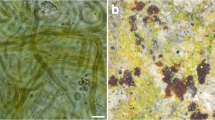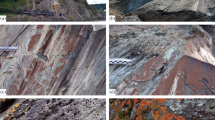Abstract
Rock art sites in the form of petroglyphs are found in the Negev Desert in southern Israel. These petroglyph sites include thousands of images depicting the life and culture of people in the region over the years. As they are part of the desert environment, these petroglyphs are exposed to natural and anthropogenic weathering processes. In natural rock sites, it is known that climatic conditions influence weathering and biofilm community development (Friedmann in Orig Life 10:223–235, 1980; Li et al. in PloS one 11:(9),163–287, 2016) Therefore, in order to develop tools for preservation and remediation, it is imperative to ascertain possible seasonal diversity of surface-inhabiting bacterial communities. To do so, we undertook to study and characterize the microbial communities inhabiting the rock sites during winter and summer. Next-generation sequencing (NGS) technologies using 16S rRNA gene were implemented on rock-surface slab samples to identify the microbial communities. 16S rRNA gene sequencing data revealed the presence of five main bacterial phyla, among them Actinobacteria, Cyanobacteria, Proteobacteria, Bacteroidetes, and Chloroflexi across the analyzed sites. The predominant phylum was Cyanobacteria (10–60% relative abundance), followed by Actinobacteria (20–60% relative abundance), Proteobacteria (5–35%), Bacteroidetes (0.02–35%), and Chloroflexi (1–12%). There was no significant difference in the bacterial diversity between samples from winter and summer. Five main phyla were observed in samples from the two seasons, winter (December) 2017 and summer (July) 2018. This study provides an important first step in understanding the possible seasonal dynamic of bacterial communities associated with the petroglyphs.





Similar content being viewed by others
References
Büdel B, Weber B, Kühl M, Pfanz H, Sültemeyer D, Wessels D (2004) Reshaping of sandstone surfaces by cryptoendolithic cyanobacteria: bioalkalization causes chemical weathering in arid landscapes. Geobiology 2(4):261–268
Caporaso JG, Kuczynski J, Stombaugh J, Bittinger K, Bushman FD, Costello EKHuttley G.A (2010). QIIME allows analysis of high-throughput community sequencing data. Nat Methods 7(5): 335–336
Chanal A, Chapon V, Benzerara K, Barakat M, Christen R, Achouak W, Barras F, Heulin T (2006) The desert of Tataouine: an extreme environment that hosts a wide diversity of microorganisms and radiotolerant bacteria. Environ Microbiol 8:514–525
Chimienti G, Piredda R, Pepe G (2016) Profile of microbial communities on carbonate stones of the medieval church of San Leonardo di Siponto (Italy) by Illumina-based deep sequencing. Appl Microbiol Biotechnol 100:8537
Chrispim CA, Gaylarde CC (2005) Cyanobacteria and biodeterioration of cultural heritage: a review. Microb Ecol 49(1):1–9
Costello EK, Schmidt SK (2006) Microbial diversity in alpine tundra wet meadow soil: novel Chloroflexi from a cold, water-saturated environment. Environ Microbiol 8(8):1471–1486
Danin A (1999) Desert rocks as plant refuge in the near east. Bot Rev 2(65):95–167
Dong H, Rech JA, Jiang H, Sun H, Buck BJ (2007) Endolithnic cyanobacteria in soil gypsum: occurences in Atacama (Chile), Mojave (United States), and Al-Jafr Basin (Jordan) Deserts. J Geophys Res 112:G02030. https://doi.org/10.1029/2006JG000385
Eisenberg-Degen D (2012). Rock art of the central Negev: documentation, stylistic analysis, chronological aspects, the relation between rock art and the natural surroundings, and reflections on the mark makers society through the Art. Ph.D. Thesis, Ben-Gurion University of the Negev, Beer-Sheba
Evenari M, Shanan L, Tadmor N (1982) The Negev: the challenge of a desert. Harvard University Press
Friedmann EI (1980) Endolithic microbial life in hot and cold deserts. Orig Life 10:223–235
Golubic SE, Friedmann I, Schneider J (1981) The lithobiontic ecological niche, with special reference to microorganisms. J Sediment Res 51(2):475–478. https://doi.org/10.1306/212F7CB6-2B24-11D7-8648000102C1865D
Gorbushina AA (2007) Life on the rocks. Environ Microbiol 9(7):1613–1631. https://doi.org/10.1111/j.1462-2920.2007.01301.x
Green SJ, Venkatramanan R, Naqib A (2015) Deconstructing the polymerase chain reaction: understanding and correcting bias associated with primer degeneracies and primer-template mismatches. PLoS One 10(5):122–128
Hillel D (1982) Negev land, water, and life in a desert environment. Prager, New York
Kidron GJ (1999) Altitude dependent dew and fog in the Negev Desert, Israel. Agriculture Forest Meteorology 96:1–8
Krumbein WE, Jens K (1981) Biogenic rock varnishes of the Negev desert (Israel): an ecological study of iron and manganese transformation by cyanobacteria and fungi. Oecologia 50:25–38
Kuhlman KR, Venkat P, La Duc MT, Kuhlman GM, McKay CP (2008) Evidence of a microbial community associated with rock varnish at Yungay, Atacama Desert, Chile. J Geophys Res Biogeosci 113(G4)
Li Q, Zhang B, He Z, Yang X (2016) Distribution and diversity of bacteria and fungi colonization in stone monuments analyzed by high-throughput sequencing. PLoS One 11(9):163–287
Northup DE, Snider JR, Spilde MN, Porter ML, van de Kamp JL, Boston PJ, Bargar JR (2010) Diversity of rock varnish bacterial communities from Black Canyon, New Mexico. J Geophys Res Biogeosci 115(G2)
Rainey FA, Ray K, Ferreira M, Gatz BZ, Nobre MF, Bagaley D, Small AM (2005) Extensive diversity of ionizing-radiation-resistant bacteria recovered from Sonoran Desert soil and description of nine new species of the genus Deinococcus obtained from a single soil sample. Appl Environ Microbiol 71(9):5225–5235
Schloss PD, Westcott SL, Ryabin T, Hall JR, Hartmann M, Hollister B, Sahl JW (2009) Introducing mothur: open-source, platform-independent, community-supported software for describing and comparing microbial communities. Appl Environ Microbiol 7(23):7537–7541. https://doi.org/10.1007/s00248-016-0770-4
Smith HD, Baqué M, Duncan AG, Lloyd CL, McKay CP, Billi D (2014) Comparative analysis of cyanobacteria inhabiting rocks with different light transmittance in the Mojave Desert: a Mars terrestrial analogue. Int J Astrobiol 13(3):271–277
Thulani P, Makhalanyane A, Valverde E, Gunnigle A, Frossard JB, Ramond D, Cowan A (2015) Microbial ecology of hot desert edaphic systems. FEMS Microbiol Rev 39(2):203–221
Urzì C, Brusetti L, Salamone P, Sorlini C, Stackebrandt E, Daffonchio D (2001) Biodiversity of Geodermatophilaceae isolated from altered stones and monuments in the Mediterranean basin. Environ Microbiol 3(7):471–479
Villa F, Stewart SP, Klapper I, Jacob MJ, Cappitelli F (2016) Subaerial biofilms on outdoor stone monuments: changing the perspective toward an ecological framework. BioScience 66:285–294. https://doi.org/10.1093/biosci/biw006
Wierzchos J, Ascaso C, Mckay CP (2006) Endolithic cyanobacteria in halite rocks from the hyperarid core ofthe Atacama Desert. Astrobiology 6:1–7. https://doi.org/10.1089/ast.2006.6.415
Wierzchos J, de los Ríos A, Ascaso C (2012) Microorganisms in desert rocks: the edge of life. Earth International Microbiology 15:171–181
Yan F, Ge Q, Li Q, Yu M, Zhu X, Pan J (2012) Analysis of microbial community on the surface of the historic stone and nearby rock samples in Yungang Grottoes. Acta Microbiol Sin 52(5):629–636
Zhang J, Kobert K, Flouri T, Stamatakis A (2013) PEAR: a fast and accurate Illumina paired-end read merger. Bioinformatics 30(5):614–620
Acknowledgements
The Israel antiquity authorities (IAA) is acknowledged for their cooperation in this project.
Author information
Authors and Affiliations
Corresponding author
Ethics declarations
Conflict of interest
The authors declare that they have no conflict of interest.
Research involving human participants and/or animals
This article does not contain any studies with human participants or animals performed by any of the authors.
Informed consent
Informed consent was obtained from all individual participants included in the study.
Additional information
Publisher’s note
Springer Nature remains neutral with regard to jurisdictional claims in published maps and institutional affiliations.
Electronic supplementary material
ESM 1
(DOCX 48.1 kb)
Rights and permissions
About this article
Cite this article
Nir, I., Barak, H., Kramarsky-Winter, E. et al. Seasonal diversity of the bacterial communities associated with petroglyphs sites from the Negev Desert, Israel. Ann Microbiol 69, 1079–1086 (2019). https://doi.org/10.1007/s13213-019-01509-z
Received:
Accepted:
Published:
Issue Date:
DOI: https://doi.org/10.1007/s13213-019-01509-z




